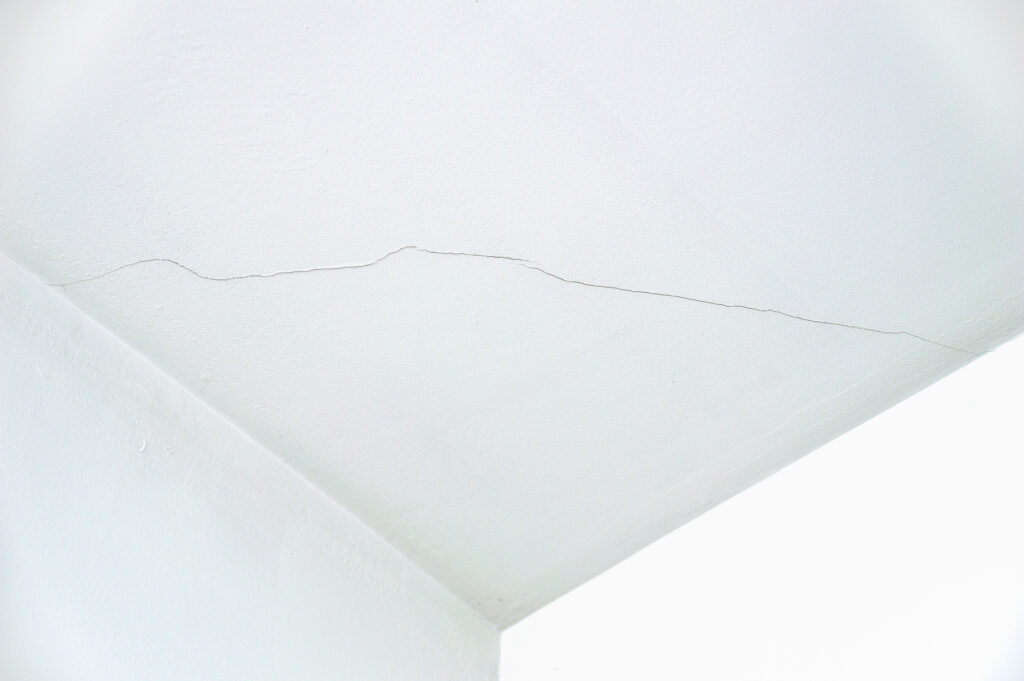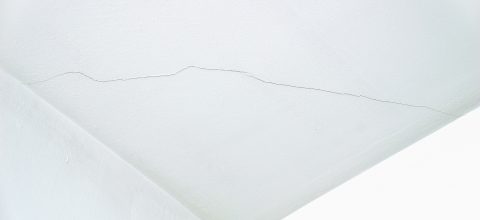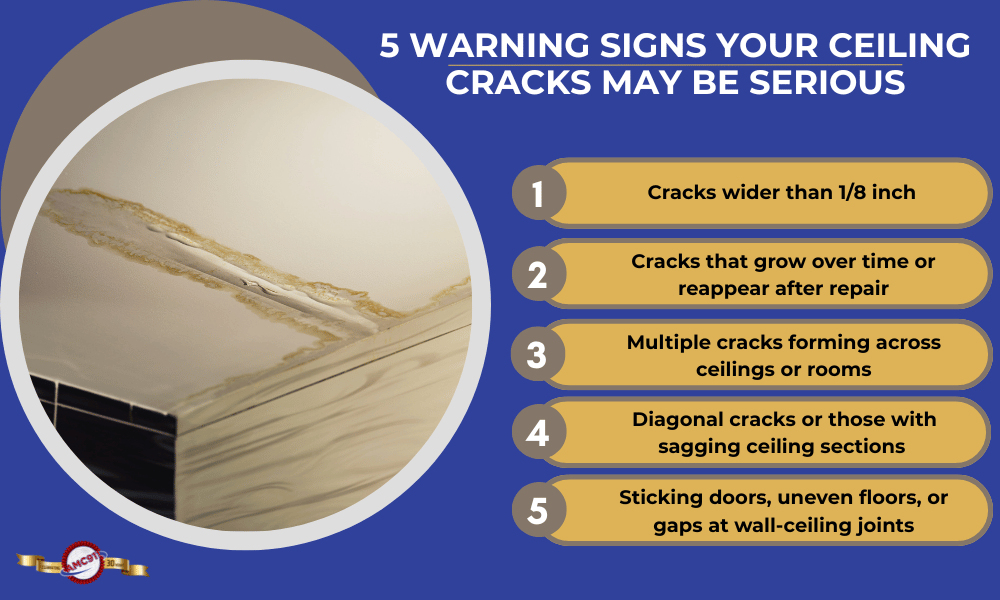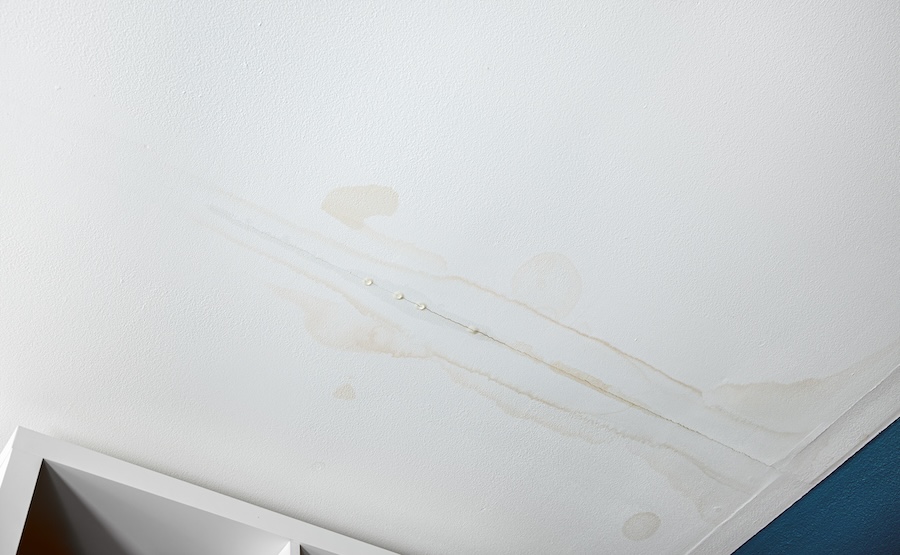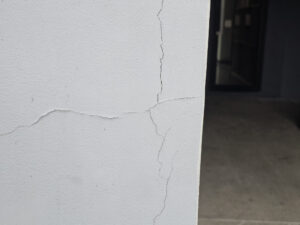A Brief Overview: Most cracks in ceiling surfaces result from normal house settling, temperature changes, or minor drywall tape issues. However, cracks wider than 1/8 inch, those showing sagging, or cracks extending from your ceiling down the walls require immediate professional attention. These warning signs may indicate structural damage that could compromise your home’s safety.
Understanding when ceiling cracks signal trouble versus normal wear can save you thousands in unnecessary repairs while ensuring you don’t ignore serious structural issues. This guide will help you identify the difference and know exactly when to call for professional help.
Understanding Different Types of Ceiling Cracks
Not all ceiling cracks are created equal. The type, size, and location of cracks in your ceiling tell different stories about your home’s condition.
Hairline Cracks: Common in new or renovated homes, hairline cracks are thin, shallow, and usually caused by natural settling. They’re mostly cosmetic and can be easily repaired if needed.
Vertical and Diagonal Cracks: These cracks often result from settling, soil movement, or construction issues. If paired with sticking doors, uneven floors, or wall gaps, they may signal foundation problems that require professional inspection.
Horizontal Cracks: More serious than vertical cracks, horizontal cracks—especially in basements—often point to structural issues from soil or hydrostatic pressure. They weaken walls and should be addressed promptly by a professional.
Stair-step Cracks: Appearing in brick or block walls, stair-step cracks indicate uneven foundation settling. They can worsen from soil erosion, drainage problems, or seismic activity. A professional evaluation is essential to prevent further structural damage.
Harmless Ceiling Cracks
Hairline crack patterns are the most common type you’ll encounter. These thin, superficial marks in plaster or drywall typically measure less than 1/16 inch wide. A hairline crack usually appears when your house naturally settles or when temperature changes cause slight material expansion.
Straight crack lines often develop along drywall tape seams. These cracks commonly occur when the original drywall installation wasn’t perfect or when a layer of paint has aged and contracted. Small cracks near corners where walls meet the ceiling are particularly normal in an old house.
Seasonal stress cracks may appear and disappear with weather changes. These thin cracks often close up during humid months and reopen when winter air dries out your home.
Warning Signs in Ceiling Cracks
Larger cracks measuring more than 1/8 inch wide demand immediate attention. These may indicate structural damage, foundation problems, or major issues with your ceiling drywall support system.
Diagonal cracks running at angles across your ceiling often point to foundation settling or structural movement. Unlike straight crack patterns that follow construction joints, diagonal cracks suggest your home is shifting in ways it shouldn’t.
Sagging ceiling sections combined with any cracking represent an emergency situation. This combination signals potential major structural damage that could lead to ceiling collapse.
Common Causes Behind Ceiling Problems
Understanding why ceiling cracks develop helps you determine their severity and potential solutions.
Normal House Movement
Foundation settling affects every part of your home, including the ceiling surfaces. New construction experiences significant settling in the first few years, while older homes continue minor settlement throughout their lifespan. This natural process creates small cracks that rarely indicate structural problems.
Truss uplift causes seasonal ceiling movement, particularly during winter months when roof trusses expand and contract. This movement can create temporary cracks that close during warmer weather. Roof trusses naturally move with temperature and moisture changes, sometimes slightly lifting the ceiling drywall.
Temperature fluctuations cause all building materials to expand and contract. Wood framing, plaster, and drywall all respond differently to these changes, creating stress points where cracks may develop.
Construction and Material Issues
Several installation-related factors contribute to ceiling crack development:
- Improper drywall installation with inadequate tape application
- Poor foundation work that allows excessive settlement
- Inadequate moisture barriers leading to material degradation
- Substandard filler application during initial construction
An old house often shows more ceiling issues simply because construction standards and materials have improved significantly over the decades.
Environmental Factors
Water damage from plumbing leaks or roof issues creates serious ceiling problems. Moisture weakens plaster and drywall, leading to sagging and cracking. Even minor plumbing leaks behind walls can cause ceiling damage in rooms below.
Poor ventilation allows humidity to affect ceiling materials over time. Bathrooms and kitchens without proper ventilation systems often develop ceiling cracks from constant moisture exposure.
Foundation problems below ground level can manifest as ceiling cracks throughout your home. When foundation settlement occurs unevenly, the resulting structural stress appears in ceiling surfaces.
When Ceiling Cracks Signal Serious Structural Issues
Recognizing dangerous ceiling cracks can prevent catastrophic failures and protect your family’s safety.
Red Flag Warning Signs
Size and growth patterns provide the clearest danger signals. Any crack wider than 1/8 inch requires professional evaluation. Cracks that continue growing over weeks or months indicate active structural movement that won’t resolve on its own.
Multiple crack patterns appearing simultaneously suggest foundation or framing problems affecting your entire home. When several ceiling areas develop cracks within a short timeframe, major structural damage may be occurring.
Accompanying Symptoms to Watch
Pay attention to these additional warning signs:
- Doors and windows that suddenly stick or won’t close properly
- Gaps appearing between walls and ceiling surfaces
- Floor areas that feel uneven or springy
- New cracks appearing in multiple rooms simultaneously
Foundation settlement often announces itself through ceiling damage before basement or crawl space problems become obvious. The structural integrity of your entire home depends on a stable foundation, and ceiling cracks may be your first warning of foundation issues.
Professional Assessment Triggers
Structural problems require immediate professional evaluation when cracks show any of these characteristics:
- Crack width exceeding 1/8 inch
- Sagging or bowing ceiling sections
- Cracks that reappear after repair
- Water stains accompanying cracks
Don’t attempt DIY repairs on cracks showing these warning signs. A foundation repair contractor can assess whether structural issues threaten your home’s safety and determine appropriate repair strategies.
How AMC911 Provides Comprehensive Ceiling and Foundation Solutions
When ceiling cracks indicate serious structural issues, our team at AMC911 offers complete solutions that address both visible damage and underlying causes. With over 30 years of experience serving Hampton Roads homeowners, we understand how foundation problems manifest throughout your home.
Our Complete Assessment Process
Our in-house engineering team conducts thorough evaluations that examine your entire structural system. We don’t just patch ceiling cracks; we identify why they occurred and prevent future problems. Our structural engineers evaluate everything from foundation settlement to roof truss movement, ensuring we address root causes rather than symptoms.
What Sets Us Apart
Engineered solutions form the backbone of our approach. Every project receives custom engineering designed specifically for your home’s unique challenges. Our uniformed, background-checked employees complete all work in-house, ensuring quality control throughout your project.
As Class A contractors with the Better Business Bureau A+ rating, we’ve built our reputation on solving complex structural problems. Our family-owned business understands that your home represents your family’s safety and financial security.
Getting Started
Don’t let ceiling cracks become major problems. Our team provides free evaluations to determine whether your ceiling issues indicate structural damage requiring immediate attention or simple cosmetic repairs.
We provide foundation repairs, waterproofing services, & masonry repairs to Virginia Beach, Chesapeake, Norfolk, Suffolk, and the entire Hampton Roads area with the same commitment to quality that has guided us for over three decades. When ceiling cracks threaten your home’s structural integrity, our engineered solutions provide permanent fixes that protect your investment.
Contact AMC911 today to schedule your comprehensive structural evaluation and learn how our proven foundation repair expertise can restore your home’s safety and value.

